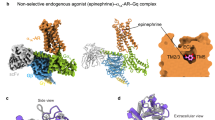Abstract
This study examined the activity of chemically diverse α2 adrenoceptor ligands at recombinant human (h) and native rat (r) α2A adrenoceptors as compared with 5-HT1A receptors. First, in competition binding experiments at hα2A and h5-HT1A receptors expressed in CHO cells, several compounds, including the antagonists 1-(2-pyrimidinyl)piperazine (1-PP), (±)-idazoxan, benalfocin (SKF 86466), yohimbine and RX 821,002, displayed preference for hα2A versus h5-HT1A receptors of only 1.4-, 3.6-, 4-, 10- and 11-fold, respectively (based on differences in pK i values). Clonidine, brimonidine (UK 14304), the benzopyrrolidine fluparoxan and the guanidines guanfacine and guanabenz exhibited intermediate selectivity (22- to 31-fold) for hα2A receptors. Only the antagonist atipamezole and the agonist dexmedetomidine (DMT) displayed high preference for α2 adrenoceptors (1290- and 91-fold, respectively). Second, the compounds were tested for their ability to induce h5-HT1A receptor-mediated G-protein activation, as indicated by the stimulation of [35S]GTPγS binding. All except atipamezole and RX 821,002 exhibited agonist activity, with potencies which correlated with their affinity for h5-HT1A receptors. Relative efficacies (Emax values) were 25–35% for guanabenz, guanfacine, WB 4101 and benalfocin, 50–65% for 1-PP, (±)-idazoxan and clonidine, and over 70% for fluparoxan, oxymetazoline and yohimbine (relative to 5-HT =100%). Yohimbine-induced [35S]GTPγS binding was inhibited by the selective 5-HT1A receptor antagonist WAY 100,635. In contrast, RX 821,002 was the only ligand which exhibited antagonist activity at h5-HT1A receptors, inhibiting 5-HT-stimulated [35S]GTPγS binding. Atipamezole, which exhibited negligeable affinity for 5-HT1A receptors, was inactive. Third, the affinities for rα2A differed considerably from the affinities for hα2A receptors whereas the affinities for r5-HT1A differed much less from the affinities for h5-HT1A receptors. This affected markedly the affinity ratios of certain compounds. For example, (±)-idazoxan was only 3.6-fold selective for hα2A versus h5-HT1A but 51-fold selective for rα2A versus r5-HT1A receptors. Conversely, yohimbine was tenfold selective for hα2A versus h5-HT1A adrenoceptors but 4.2-fold selective for rα2A versus r5-HT1A receptors. Nevertheless, both atipamezole and DMT were highly selective for both rat and human α2A versus rat or human 5-HT1A receptors. In conclusion, these data indicate that: (1) the agonist DMT and the antagonist atipamezole are the ligands of choice to distinguish α2-mediated from 5-HT1A-mediated actions, whilst several of the other compounds show only low or modest selectivity for α2A over 5-HT1A receptors; (2) caution should be exercised in experimental and clinical interpretation of the actions of traditionally employed α2 ligands, such as clonidine, yohimbine and (±)-idazoxan, which exhibit marked agonist activity at 5-HT1A receptors.
Similar content being viewed by others
Author information
Authors and Affiliations
Additional information
Received: 2 March 1998 / Accepted: 11 May 1998
Rights and permissions
About this article
Cite this article
Newman-Tancredi, A., Nicolas, JP., Audinot, V. et al. Actions of α2 adrenoceptor ligands at α2A and 5-HT1A receptors: the antagonist, atipamezole, and the agonist, dexmedetomidine, are highly selective for α2A adrenoceptors. Naunyn-Schmiedeberg's Arch Pharmacol 358, 197–206 (1998). https://doi.org/10.1007/PL00005243
Issue Date:
DOI: https://doi.org/10.1007/PL00005243




